- Personal
- Small Business
- Corporate & Institutional
-
About
-
Company Profile
Corporate Sponsorship
-
Corporate Responsibility
- Investor Relations
-
Careers
Our Workplace
Find Your Place
Life at PNC
-
Company Profile
-
Español
false xf false
- Customer Service
- Locations
- Security
Welcome to PNC! How can we help you today?

Artifacts
National City Bank
In 2008, PNC acquired National City Bank, Cleveland's oldest bank known for its commercial leadership, service to its customers, and its contributions to the community. As PNC upholds the core values of National City, it will also preserve the documents that tell its story.
National City maintained an archive that documented its business and commercial relationships, but especially its outreach to the consumers of northern Ohio. The holdings of several area repositories supplement these holdings to yield a rich story of not merely National City's history but its predecessors as well. The PNC Legacy Project is proud to showcase the following fifteen artifacts and hope they serve to heighten the viewers' appreciation and understanding of past eras.
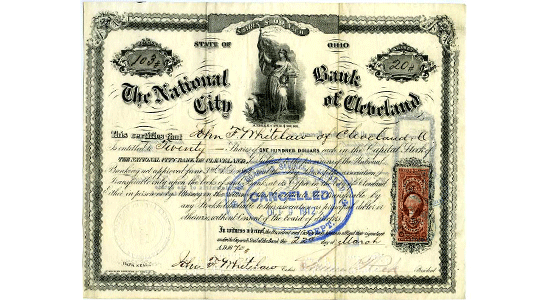
NCB Stock Certificate | 1870
National City Bank
Between 1865 and 1912, John F. Whitelaw was the dominant figure at National City Bank. Before taking over as President in 1889, he worked as a cashier. Whitelaw selected the people associated with the bank. The Board and staff consisted of a small group of personal friends and family members. He also personally selected the depositors, the elite of Cleveland. This NCB stock certificate was issued to Whitelaw in 1870. He retained ownership of his NCB stocks until his death in 1912.
NCB Historical Collection
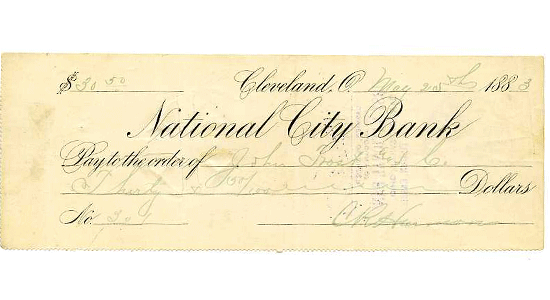
Bank Check | 1883
National City Bank
Banks take security measures with checks, like any financial instrument. In the 19th century, bankers punched holes to mark cancelled checks. Shown here is a National City Bank check dated May 25, 1883
NCB Historical Collection
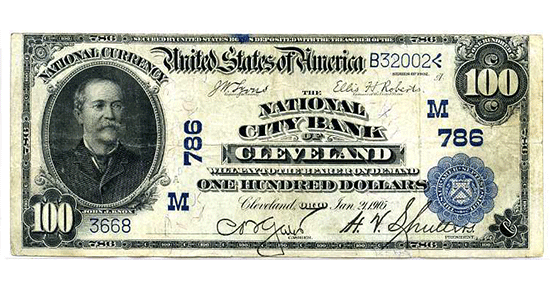
$100 Bank Note | 1906
National City Bank
National City Bank's status as a national bank empowered it to issue currency in its own name. National bank notes included the name of the issuing bank, but the coloring, engraved seals, and images were uniform throughout the nation. Shown here is a $100 bank note, 1906 series
NCB Historical Collection
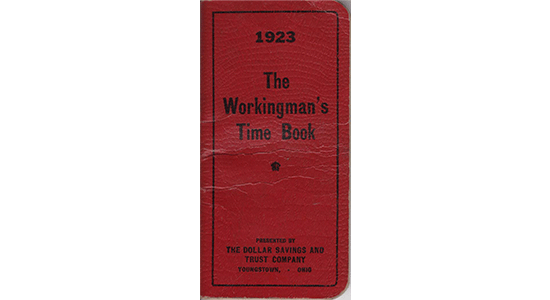
The Workingman's Time Book | 1923
National City Bank
Savings banks not only spoke the languages of their depositors, but they also reached out to them at work and their households. The Dollar Savings and Trust published this time book to encourage workers to track their hours, wage rates, the total weekly payment and amount saved.
National City Bank Collection, courtesy of the Mahoning Valley Historical Society, Youngstown
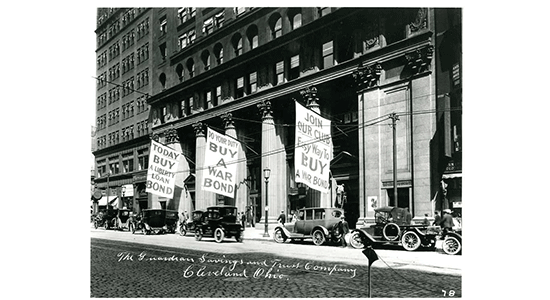
Liberty Loan Support | c. 1917
National City Bank
As the U.S. Army quickly mobilized to assist the Allied forces during World War I, the government launched the Liberty Loan program to finance the costs. Appeals made on both the national and local level emphasized the importance of people of all stations investing in war bonds and their connection to a successful war effort. Banners promoting war bonds outside the Guardian Savings and Trust during World War I.
Courtesy of the Western Reserve Historical Society
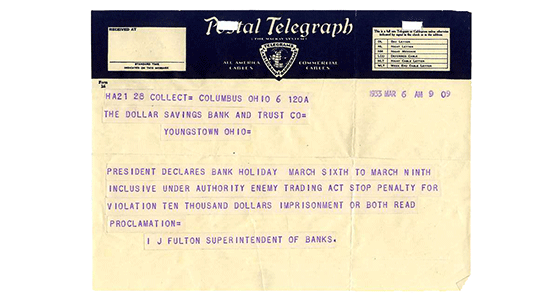
Bank Holiday Telegram | 1933
National City Bank
Franklin Delano Roosevelt took office in the midst of an economic crisis in March 1933. Immediately, he initiated an energetic program to stabilize the banking system. It included a bank holiday enabling the evaluation of every bank in the nation, and the creation of the Federal Deposit Insurance Corporation. This telegram from the Superintendent of Banks to the Dollar Savings and Trust, Youngstown, announced the bank holiday beginning March 6, 1933.
NCB Historical Collection
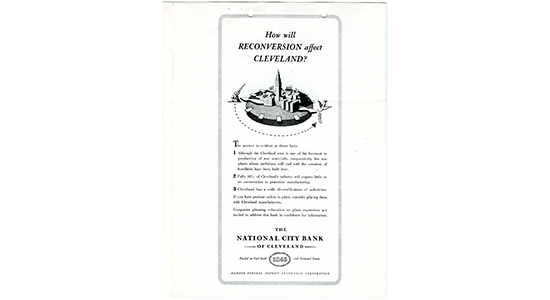
Wartime Mobilization Ad | 1944
National City Bank
Private investment supplemented the public financing of wartime mobilization. National City Bank fostered private investment in key sectors that later provided the foundation of the postwar economy. Originally appearing in The Wall Street Journal and Business Week, this advertisement brought that message to businessmen nationwide.
NCB Historical Collection
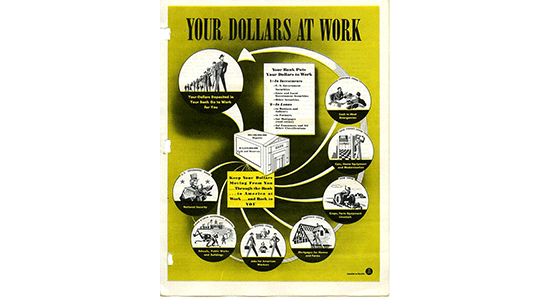
Advertisement | c. 1945
National City Bank
Designed to promote deposits from people with modest incomes, this poster illustrates the various sectors, including national security, that benefit from bank investments.
Dollar Savings and Trust Records, NCB Historical Collection
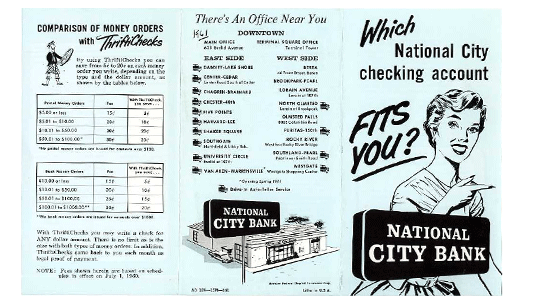
Homemakers' Brochure | c. 1950
National City Bank
In the early 1950s, National City targeted homemakers as a customer base. Their appeal was evident not only in printed matter, but also in their sales pitch. "Home Service Representatives" called on 15,000 homes in Greater Cleveland to introduce women to the banking services offered by National City.
NCB Historical Collection
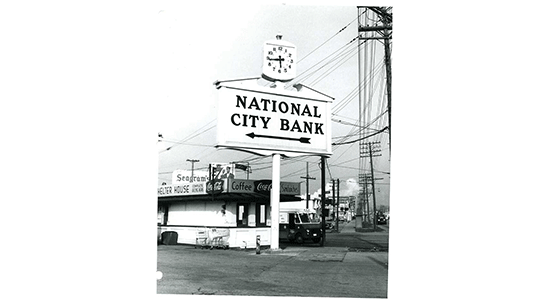
National City Sign | c. 1950
National City Bank
By the 1950s, National City customers could make a pit stop to conduct simple bank business. Drivers could not miss this large sign, pointing to the Brookpark-Pearl branch.
NCB Historical Collection
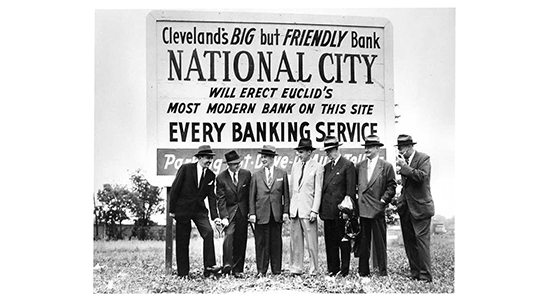
Ground Breaking | 1955
National City Bank
National City promoted itself as the "big and friendly" bank. Several officers break ground at the Babbitt-Lake Shore branch in 1955.
NCB Historical Collection
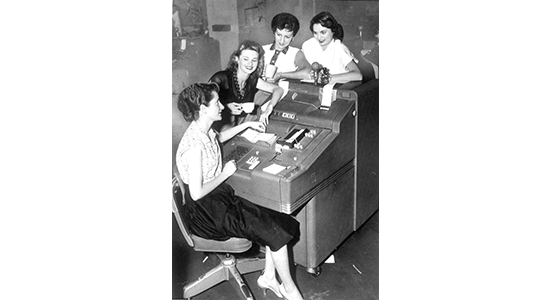
Employees with Check Sorter | 1956
National City Bank
Four National City employees taking a break around an IBM check sorter. These machines simplified the task of verifying and posting checks to the individual accounts.
Cleveland Press Collection, courtesy of Cleveland State University
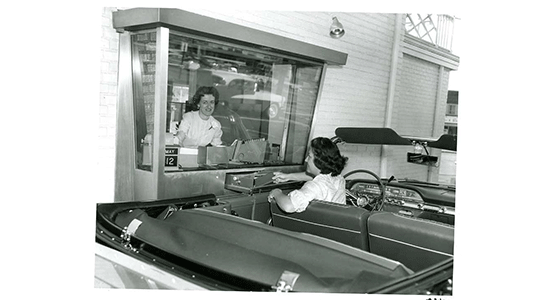
Auto-Teller | 1961
National City Bank
These auto-tellers provided convenient service and became part of the car-friendly Cleveland landscape. This customer did not even need to open her window to make a deposit with the auto-teller, Carol Richmond, at the Van Aken-Warrensville Office.
NCB Historical Collection
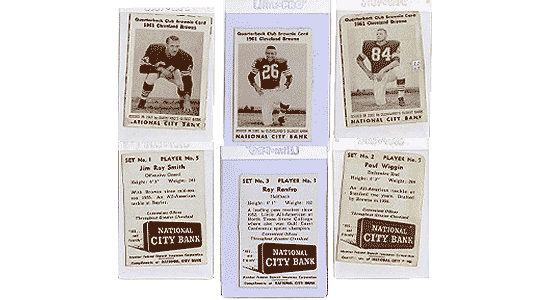
Football Trading Cards | 1961
National City Bank
These Cleveland Browns' trading cards reminded young and old sports fans to bank at National City and featured Jim Ray Smith, Ray Rentro and Paul Wiggin, 1961.
NCB Historical Collection
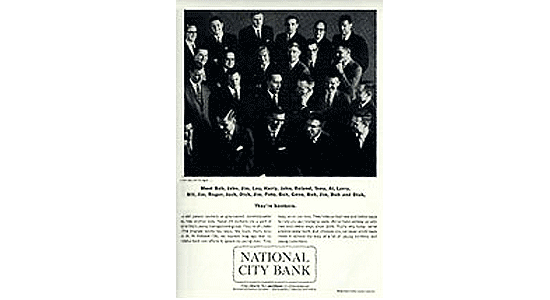
Advertisement | 1965
National City Bank
Advertisement directed to bank professionals' projects its workforce as youthful and energetic. National City also took pride in their expertise, nurtured by the most experienced bankers in Cleveland. The ad appeared in Polk's Bank Directory.
NCB Historical Collection
Related Resources
Important Legal Disclosures and Information
Read a summary of privacy rights for California residents which outlines the types of information we collect, and how and why we use that information.
The PNC Financial Services Group, Inc. All rights reserved.





